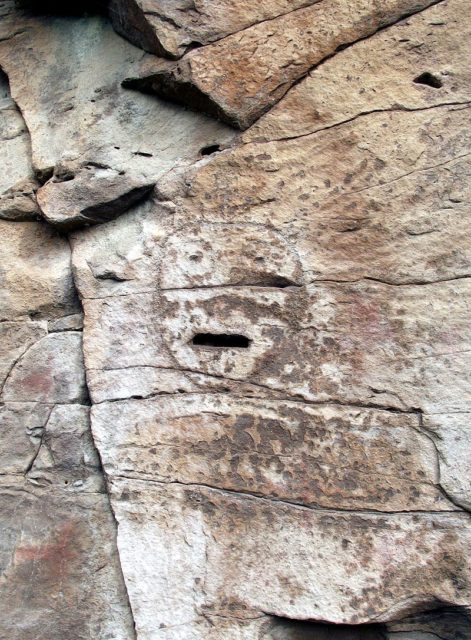Most likely from Okunev Culture, could this mysterious ancient figurine with an angry face be a child’s rattle that warded off evil spirits? This distinctive expression of ferocity and rage has never before been seen among ancient Siberian statuettes.
The fisherman Nikolay Tarasov, age 55, made this remarkable Bronze Age catch while he was on a fishing expedition for carp and tench and dipped his net into the Dudet River close to his home in the Kemerovo region.

Photo Credit
Instead of a fish he had netted a strangely-shaped stone. He considered throwing it back into the water, but at the last second took another look at it more closely. He then saw the face, and stopped to wash the figurine in the river. He then realised that it was not a stone. It had a complete face – a frightful face but a complete one. This fossilised figurine was the catch of a lifetime
Located on the reverse side, the carver had etched hair with wave-like lines. Right below the plait, there were lines that looked like fish scales. He went to the local museum, and the specialists there literally jumped for joy.
The museum staff remarked on how interesting it was that the face displayed on this figurine had a very distinctive expression. Normally, the ancient Bronze Age and Neolithic god sculptures did not have any kind of distinctive expressions. This was the other reason why this figurine is so unique. Archaeologists argue that it depicted either a spirit or a god.
From observing the style, experts believed that the figurine is from the ancient Okunev Culture.
Recent findings at an Okunev site about 300 kilometers northwest have guided them to a theory about the figure’s purpose.
Eight figurines made of horn have been discovered at Lake Itkol in Khassia. They have been described as similar to a modern child’s rattle, but were supposedly used for scaring off evil spirits. They were found in the grave of a baby that was less than a year old when it had died.
While these are far from being identical to the figure from the river, they ato be related to the style of the fisherman’s pagan god, which is currently on the public display at the Tisul History Museum.
At first, the researchers were not positive about the validity of the Itkol figures, but when the newer find seemed to be related, experts dove in, intrigued by the fact that the figurines were not exactly the same. This indicates a more advanced culture that was open to interpenetration.
For the moment, it remains a mystery as to how the figure came to be in the river. It could have been washed away by the water following the destruction of an ancient child’s burial site. The archaeologists went back to the river location, hoping there would be more archaeological items, but unfortunately, they had no luck.
It has been hard to tie this statue to specific Okunev burials or settlements. The nearest known settlement from the Okunev Culture is submerged underwater in the modern Tambarskoye Reservoir 10 kilometers (6.2 miles) from the location where the figurine was discovered.
The discovery was made upstream of this submerged archaeological location. This statue was made of antler, and it was very detailed. The Okunev are known to have been very artistic, judging from previous burial grounds that have been found. Archaeologists suppose that it displays a cape or mantle created of scales.

Archaeologists suppose that the detailing below the figurine’s hair represents a cape or made created of scales. This could possible relate to this ancient culture’s beliefs about the afterlife.
There was a hole drilled into this figurine; archaeologists found a small wooden stick, possibly a twig, inside of the hole. A theory now is that the figurine was placed on a tree branch and at some point and could have broken off with the small twig embedded in it.
The archaeologists say it is a true miracle that Nikolay Tarasov discovered the artifact. They are very proud that a statue created by the legendary Okunevs is in the collection of the museum. It is considered one of the most significant archaeological exhibits in the museum’s collection. It is now on public display, and they welcome people to come to see it. They have faith that this figurine might display one of the spirits or gods that the Okunevs had believed in. It appears scary but is fascinating to look at, and they feel the visitors would love to see it.
So if you would enjoy seeing this artifact, go take a look for yourself! Maybe you can figure out its mystery if you have the knowledge, or if you just enjoy seeing old things from a glorious culture that no longer exists. We are still learning more and more about such cultures with each new discovery.
